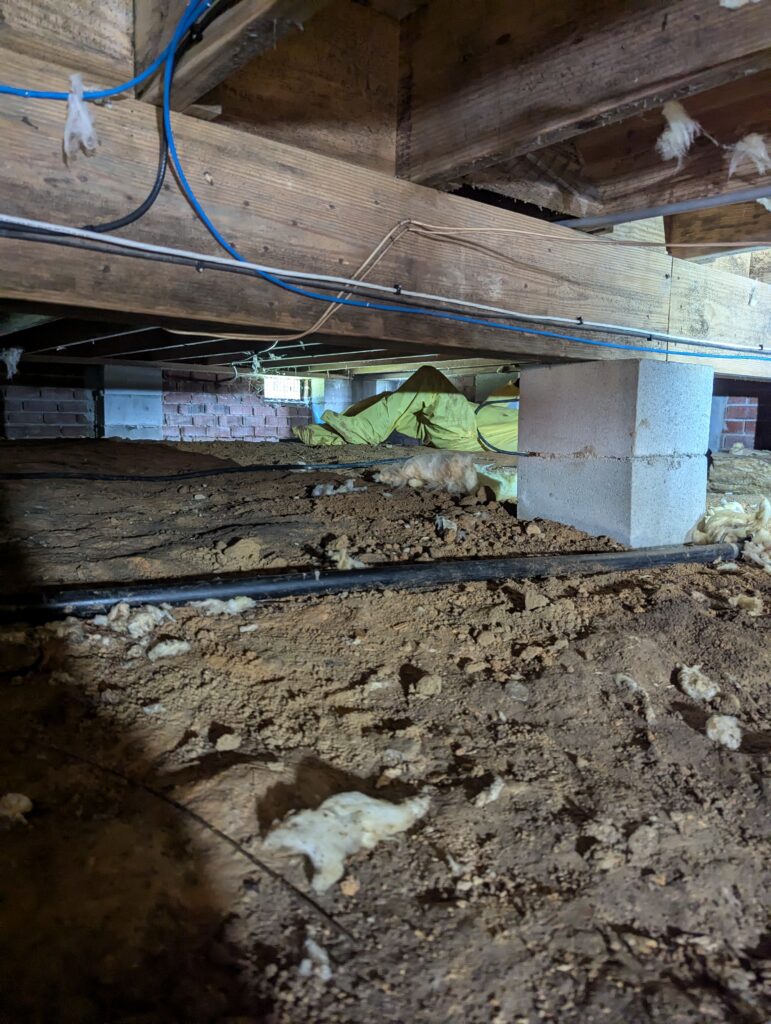
You have a feeling that something is off in your home in Prince George, VA, or a surrounding area. Maybe it’s a weird smell you can’t place, or your allergies are suddenly acting up for no reason. It’s easy to ignore the dark, dusty area beneath your floors, but those could be early signs of crawl space mold.
That unseen space is a prime spot for problems that can affect your whole house. Understanding the common signs of crawl space mold helps you catch the issue early and protect your home.
Your crawl space sits directly on top of the earth. The ground is naturally full of moisture, which can seep upward as water vapor. This process creates the perfect damp, dark environment that mold loves.
Without good airflow, that humid air gets trapped. It condenses on cooler surfaces like your floor joists and insulation, giving mold spores exactly what they need to start growing. This poor air quality in the crawl space can directly impact the air you breathe upstairs through a process known as the stack effect, where air naturally rises and enters your living area.
Spotting mold isn’t always about seeing big, fuzzy patches. Sometimes, the clues are much more subtle. Paying attention to these indicators can save you from costly water damage and potential health risks.
If you notice a persistent musty smell, that’s often the first and most obvious clue. This odor comes from gases, or microbial volatile organic compounds (MVOCs), that mold releases as it grows and digests organic materials. You might notice it more strongly near vents or on the first floor of your home.
This smell is a direct result of the mold’s life cycle. So if your home smells like damp soil or old, wet clothes, it’s time to consider a crawl space inspection.
Are you constantly coughing, sneezing, or dealing with itchy eyes inside your own house? Mold spores are common allergens that can trigger these reactions. When a crawl space has mold, those spores can easily travel into your living areas through small gaps and your HVAC system, harming your home’s air quality.
According to the Centers for Disease Control and Prevention (CDC), mold exposure can cause a variety of health effects. If your symptoms improve when you leave the house, mold could be the underlying cause.
This is one of the more serious signs of a problem. Mold feeds on organic materials like the wood in your subfloor and floor joists. Over time, this feeding process causes the wood to weaken, leading to wood rot.
If you feel a bounce or dip when walking across the floor, the structural supports may be compromised. Don’t ignore this, because it points to a well-established moisture and mold problem that may require foundation repair.
Many insects and other pests are drawn to damp, moldy places. Cockroaches, camel crickets, and termites thrive in high-humidity environments. The mold itself can even be a food source for some of them.
Seeing an unusual number of pests could mean your crawl space is the perfect home for them. A damp, moldy environment is exactly what they’re looking for.
Mold isn’t always black. It can show up as white, green, yellow, or brown spots. You might see this discoloration on your wooden beams, insulation, or even on the dirt floor of the crawl space.
These stains can look fuzzy, slimy, or like simple water marks at first. While many people worry about toxic black mold, any strange coloring on the surfaces in your crawl space warrants a closer look, as all molds can cause problems.
Moisture and mold work together to destroy wood. If you can easily insert a screwdriver into a wooden support beam in your crawl space, you have a problem. The wood is likely decaying from the inside out.
This process of wood rot severely damages the structural integrity of your home. Healthy wood should be firm and solid, not soft and crumbly.
If you’ve noticed any of these signs, don’t panic. The first step is to seek professional help from an insulation contractor and crawl space expert. They can safely inspect the area, perform mold testing to identify the type and concentration of mold, and find the moisture source that’s causing it.
For very small areas of surface mold, you might be able to clean them yourself with the right protective gear. But for anything larger than a few square feet or for mold that has damaged structures, it’s best to call in a professional for mold remediation.
Attempting a large-scale do-it-yourself removal can disturb the mold, releasing millions of spores into the air and exacerbating the problem.
Once the mold is gone, you need to make sure it doesn’t come back. The key is controlling moisture. Here are a few effective steps you can take.
Taking these preventive measures helps protect your home from future mold problems. It also keeps your crawl space dry and your indoor air healthy.
Your crawl space might be out of sight, but it shouldn’t be out of mind. Learning these important signs of crawl space mold can help you protect both your family’s health and your home’s foundation. Being proactive and addressing moisture issues early is the best way to keep this hidden part of your home safe and dry.